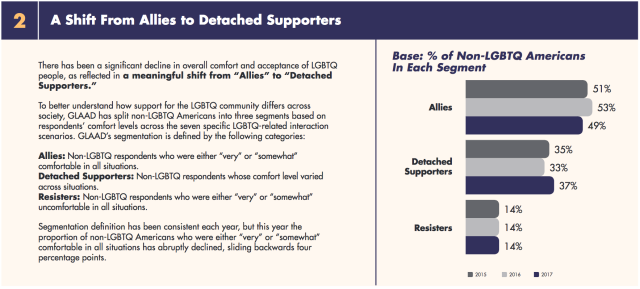Four years ago, GLAAD added one more metric to the toolbox we have at our disposal for measuring the cultural standing of LGBTQ people in the US when they asked the Harris Poll to launch an index that explicitly asks respondents about their level of acceptance of LGBTQ people. The survey asks about the respondents’ level of comfort with interacting with LGBTQ people in everyday social situations like the doctor’s office or place of worship, whether LGBTQ respondents report experiencing discrimination, and the degree to which respondents support “equal rights” for LGBTQ people. As one would expect, the numbers have generally trended more and more towards acceptance as time and progress march on, with numbers either improving or staying the same since the beginning of the index. That is, until last year — when, as GLAAD CEO Sarah Kate Ellis puts it, “the acceptance pendulum abruptly stopped and swung in the opposite direction.”
Compiled in the Accelerating Acceptance report, the index found that after a dip in the reported discomfort in 2016, in 2017 levels of social discomfort with LGBTQ people rose across the board. More non-LGBTQ respondents than last year said they were either “somewhat” or “very” uncomfortable in every imagined hypothetical scenario, ranging from having an LGBTQ doctor to their child learning about LGBTQ history in school to finding out that their own family member is a member of the LGBTQ community. In the case of “learning [my] child was placed in a class with an LGBT teacher,” respondents were actually more uncomfortable than they were in 2014, the beginning of the survey.

Unsurprisingly, at the same time as the non-LGBTQ respondents are reporting their rising discomfort with us, the LGBTQ respondents are reporting higher levels of discrimination. (In 2017, 12% of the respondents self-identified as LGBTQ and 88% did not; in 2016, 17% of the respondents were LGBTQ.) Increased numbers of people reported discrimination on the basis of sexual orientation or gender identity — the percentage jumped 11% since 2016 — as well as on the basis of disability, religion, age, and “other areas.” In fact, the only area in which LGBTQ respondents didn’t report increased discrimination was on the basis of race and ethnicity, which saw a 4% drop in reported discrimination.
Why such a sharp shift across the board? GLAAD suggests we look at the “heightened rhetoric toward marginalized
communities” that ramped up in a particular way during the election cycle in 2016 and stayed up after the inauguration in 2017, as well as the ways in which LGBTQ issues have appeared constantly in the headlines as a matter of debate and the fact that “LGBTQ visibility slipped in news and entertainment media.” (In our own analysis earlier this year, we noted that “in 2016, GLAAD’s annual report revealed that lesbian representation had gone down for the first time since 2004, and ‘while bisexual women are getting a small boost in visibility, it’s often coming at the cost of damaging cliché.’ Our Senior Editor Heather Hogan called 2016 ‘the most frustrating year ever for queer women who love television,’ even compared to years when we had ‘hardly any TV representation at all.’”)
It’s true that when far-right and ultraconservative candidates or issues are dominating the national conversation, especially when they become law, we see increased negative sentiment and violence against marginalized groups — racially and religiously motivated hate crimes rose by a shocking 41% in England and Wales after Brexit. The data for the 2017 survey was gathered from November 16-20 of 2017, in the heady weeks following the results of the US election and at a particular peak of intensely charged rhetoric.
Given that context, it’s interesting to note the one measured criteria of the Accelerating Acceptance report that didn’t change from 2016 to 2017 — the response to the statement “I support equal rights for the LGBT community.” In both 2016 and 2017, 79% of respondents said they either “somewhat” or “strongly” agreed. It’s interesting, given the results of the rest of the survey and the specific wording of the statement, what “equal rights” might mean to the non-LGBTQ respondents. Does it mean the right to safety from harm, to accessible and competent medical treatment, to form families and parent children, to be visibly LGBTQ in public without fear? If straight and cis people are growing more uncomfortable with us as part of their daily life and communities, if they report not wanting us to treat their illnesses or teach their children — what rights to a fully lived and safe public life do they really support for us, and to what extent would they prefer to back an abstract and undemanding sense that “love wins?” Unfortunately, there are some answers the survey can’t give us.
It’s a somewhat grim but ultimately unsurprising reveal, given the direction national discourse and policy have taken in the past year and a half for marginalized people in the US in general and including LGBTQ people. The parallel of the President choosing Mike Pence as his running mate, attempting to ban trans people from the US military, firing the entire HIV/AIDS advisory council, allowing his administration to ban the words “diversity” and “transgender” at the Department of Health and Human Services, opening the doors for rampant life-threatening discrimination against LGBT people in healthcare, specifically revoking Obama-era protections for trans employees and so many other things — and also literally waving a rainbow flag is a bit on the nose, but unfortunately apt. In an era defined for many marginalized people by a deep cognitive schism between the protections and support we’re told we’re afforded and the reality we experience, this shift in support is disappointing but not surprising.







